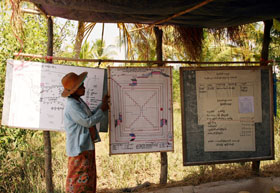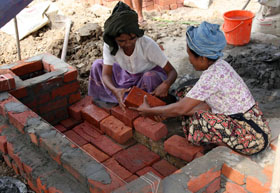Background and Objectives
Background

Cyclone Nargis struck Myanmar on2 May 2008, making landfall in the Ayeyarwady Dicision and directly hitting even the capital city of Yangon. Forty townships in Yangon Division are designed as disaster areas. It is also estimated that a total of 2.5 million people were affected. The occurrences and gravity of natural disasters and complex emergencies have risen in the past decade, particularly in the light of increased impact on settlements caused by climate change. Myanmar suffers from a multitude of natural hazards that have adversely affected a large number of already vulnerable communities through out the country. Disasters occur on a regular basis which range from cyclones, drought, earthquakes, fires-both urban and forest, landslides, floods, storm surges to tsunamis. Myanmar is the largest country in mainland of South East Asia with a total land area of 676,578 sq km, extraordinary in her diversity and containing ever kind of habitat from frozen alpine country, to tropical jungles, coral reefs and open grasslands.
UN-HABITAT intends to support various components outlined in the Myanmar Action Plan for Disaster Risk Reduction (MAPDRR), complementing the activities and addressing the gaps with other stakeholders playing an active role in the sector with generous funding from the Government of Norway. Based on a comprehensive study of Disaster susceptibility in Myanmar, the Disaster Response and Preparedness of Coastal and Urban Communities (DRP-CURB) Project prioritized focus on three principal disasters:
Cyclone/Storm Surges Floods: which will be piloted in Rakhine State (RS), Sagaing, the Ayeyarwady Division and the Yangon Division
Earthquake Mitigation: to be piloted in the urban centers and high risk areas of Yangon, Mandalay, Naypyitaw and Bago
Fire: the most frequent hazard in Myanmar occurring at urban and rural levels to be targeted in Ynagon, Bago, Mandalay, Sagaing and the Ayeyarwady.
Objectives
The overall aim of the post-disaster project is to enhance human safety and security, including that of community and urban assets, by raising the awareness of urban and coastal communities of mitigation measures in areas prone to earthquakes, fires, cyclones, storm surges, and flooding. Building on the successes of UN-HABITAT’s interventions in the DRR sector and programs, the DRP-CURB Project is support of the coastal and urban communities in Myanmar is designed to introduce a culture of prevention and preparedness through a comprehensive triple-action approach.
Based on the vulnerability and needs identified, and the international and national DRR priorities identified, the programme proposes the following interventions;
Objective 1: Multi-hazard resilient model-house pilots constructed & socialization of designs
Objective 2: Policy and technical support to relevant ministries
Objective 3: Generate baseline & secondary information on land use for advocacy activities
Objective 4: Capacity development of local artisans & carpenters on disaster resistant construction practices with increased sustainable livelihood options
Objective 5: Advocate community led preparedness and mitigation initiatives through small grants
Objective 6: Increase awareness on types of hazards, and build capacities of the people to mitigate
Objective 7: DRR DIAS- DRR Disaster Information Assimilation Source - One stop resource for relevant contextual info and technical advice on DRR issues in-country
Objective 8: Integrate gender perspective in data collection and indicators formulation, municipal response and documentation
Activities
* Organize a national level workshop for sharing information and knowledge on shelter designs, using the locally available materials and with sensitivity to local traditions and customs.
* Technical support for developing building codes
* Organize trainings on disaster resilient construction methods for carpenters, community facilitators, artisans
* Set up community development committees (CDCs) and conduct participatory action planning (CAP)
* Set up grant committees led by local women’s NGOs for approval of proposals, and establish joint monitoring of the approved projects together with women’s NGOs and local authorities.
* Public awareness programs on types of hazards, susceptibility of locations and build capacities of the people to mitigate
Results

* Disaster resilient housing that meets the needs of the whole household, including women
* Housing and buildings are more disaster resilient
* Income earning potential increases
Development Partners / Partners
Development Partners: Government of Norway
Government: Ministry of Development of Border Areas and National Races-Department of Development Affairs; Ministry of Construction
NGO's: Border Areas Development Association (BDA), Metta Development Foundation, Women's NGOs
Professional Societies: Myanmar Engineering Society (MES), Association of Myanmar Architects
- The Project for Emergency Support to Poor and Vulnerable Communities in Ethnic Areas
- A Short Step from Improved WASH to Healthier Communities
- The Programme for Emergency Assistance to Poor and Vulnerable Community in Ethnic Minority Areas and Yangon
- Safe and Sustainable Access to WASH for Rural Communities
- Shelter Recovery Programme – Post Giri Affected Areas
- Shae Thot ‘The Way Forward’
- Land Administration and Management Programme (LAMP) in Myanmar
- Safer Coastal and Urban Communities through DRR in Myanmar
- Disaster Risk Reduction for Safe & Resilient Burmese Coastal Communities
- The Programme for Development and Rehabilitation of Community in Ethnic Minority Area, Myanmar
- Myanmar Climate Change Alliance (MCCA)
- Rebuilding Homes-Rebuilding Lives – Coastal Settlements Sustainable Recovery (CSSR)
- Rebuilding Homes-Rebuilding Lives – Coastal Settlements Support Programme (CSSP)
- Coastal Communities Livelihood Assistance Programme (CLAP)
- Disaster Response & Preparedness – Resilient Coastal Communities and Urban Risk (DRP-CURB)
- Shelter Improvement and Disaster Risk Reduction Project
- Community Water Supply and Sanitation Recovery
- Community Based Disaster Risk Reduction (CBDRR)
- Support to the Coordination of Early Recovery Shelter Interventions-Shelter Cluster Lead
- Semi-permanent Schools in Ayeyarwady Delta in Myanmar / Multi-purpose Schools in Ayeyarwady Delta in Myanmar






































